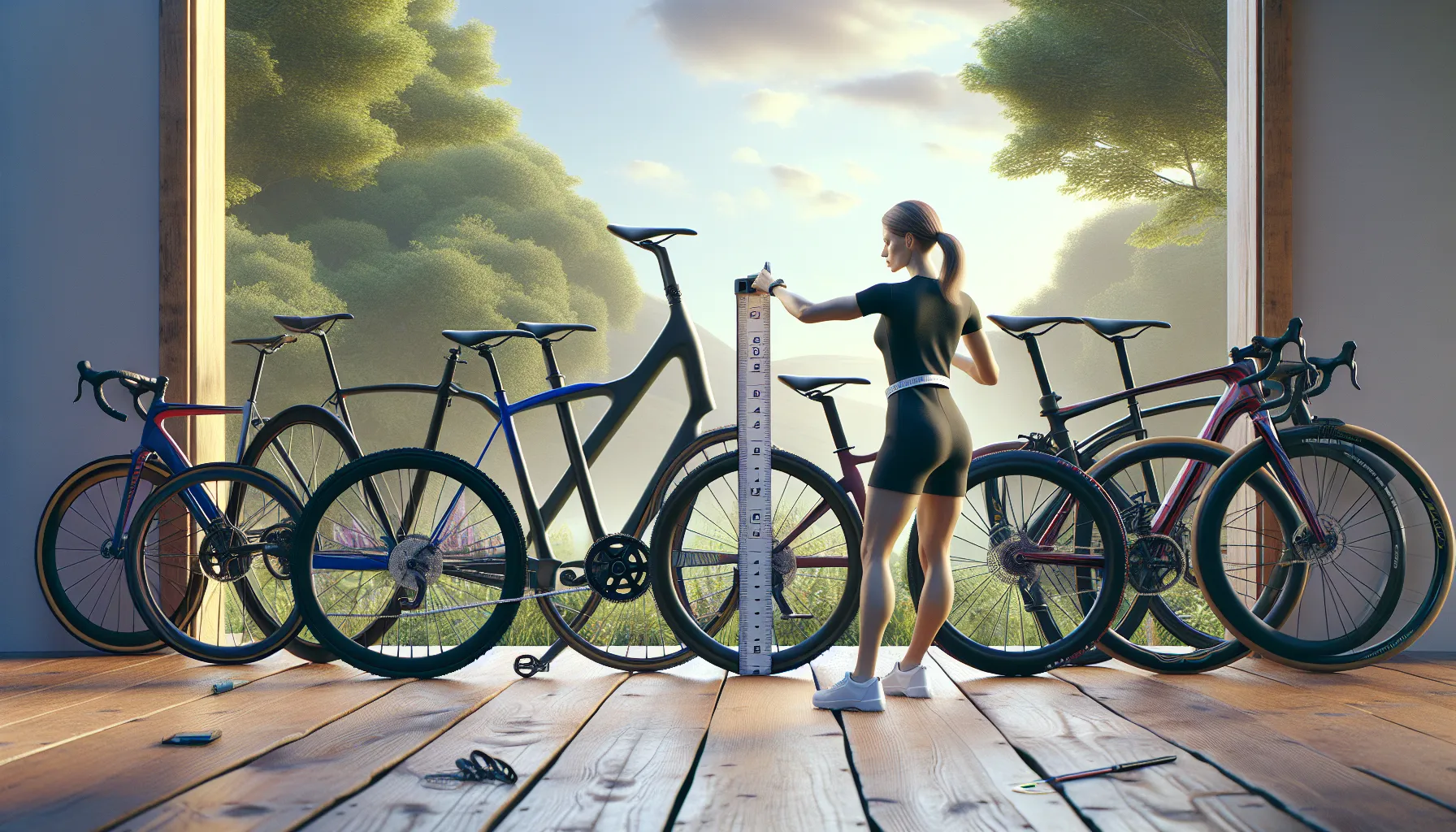What Size Bike Do I Need? Complete Guide to Choosing the Perfect Fit
Key Takeaways
- Choosing the correct bike size is crucial for comfort, safety, and reduced injury risk during rides.
- Key factors in sizing include height, inseam length, riding style, and bike type (e.g., road, mountain, or hybrid).
- Using accurate body measurements, such as inseam and height, helps match you to the appropriate frame size and geometry.
- Bike sizing varies by manufacturer, so consulting brand-specific size charts ensures a better fit.
- Test rides and professional bike fitting services help fine-tune adjustments for optimal comfort and performance.
- Avoid common mistakes, like relying solely on height, skipping test rides, or prioritizing style over proper fit.
Choosing the right bike size can feel a bit overwhelming, but trust me, it’s worth getting it right. A bike that fits you properly isn’t just more comfortable—it can completely transform your riding experience. Whether you’re cruising around town or tackling long trails, the right size makes all the difference.
I’ve been there, staring at size charts and wondering what all those measurements mean. But it doesn’t have to be complicated! With a little guidance, figuring out your perfect bike size can be simple and even fun. Let’s dive into what you need to know to find a bike that feels like it was made just for you.
Importance Of Choosing The Right Bike Size
Selecting the correct bike size ensures a comfortable ride and reduces the risk of injury. An improperly sized bike can cause back pain, knee strain, and wrist discomfort, making rides less enjoyable and potentially harmful over time.
Proper sizing improves efficiency by optimizing your body’s alignment with the bike. When the frame, handlebars, and saddle are proportioned to your body, energy transfer becomes smoother, leading to better performance. For example, a rider with a correctly sized bike pedals more effectively and maintains a steady cadence longer.
Choosing the right size also enhances control and stability. A bike that fits well feels natural to handle, especially during sharp turns or sudden stops. This increases confidence and safety, particularly in challenging terrains or urban settings.
Matching your bike size to your body measurements is critical as all manufacturers use slightly varied sizing charts. Measurements like inseam length and torso reach significantly impact how well a bike fits, so taking time to assess these factors pays off.
Factors Affecting Bike Size

Bike size depends on individual body measurements and specific riding preferences. By considering key factors, I can help ensure a perfect match for comfort, performance, and safety.
Height And Inseam Measurement
Height and inseam length serve as primary indicators for bike size. I find accurate measurements vital since inseam length influences the proper standover height for a bike. For instance, a rider with a 30-inch inseam may fit a bike with a standover height slightly less than 30 inches. Proper alignment minimizes strain and maximizes comfort during rides.
Bike Type And Riding Style
Different bike types cater to riding styles, influencing sizing requirements. For example, road bikes prioritize speed and often have smaller frames for aerodynamic efficiency, while mountain bikes offer larger, robust frames for better control on rugged terrain. I always consider my intended use—commuting, trail riding, or long-distance touring—to determine the bike type that suits me best.
Frame Size And Geometry
Frame size directly determines how well a bike accommodates my body. Manufacturers size frames by seat tube length, commonly measured in inches or centimeters. Geometry, including top tube length and head tube angle, affects posture and performance. For example, a relaxed frame geometry is suitable for casual rides, while aggressive geometry suits competitive cycling. A tailored frame ensures both comfort and control.
How To Measure Yourself For A Bike

Accurate body measurements simplify finding the right bike size. Height and inseam length play a crucial role in this process.
Step-By-Step Guide To Measure Height
Stand barefoot on a flat surface for accurate height measurement. Keep your back straight and heels against a wall. Place a flat object, like a book, on your head, ensuring it touches the wall. Mark where it meets the wall, then measure from the floor to the mark. Write down the value in inches or centimeters, depending on your preferred system of measurement.
Finding Your Inseam Measurement
Wear snug clothing to get an accurate inseam measurement. Stand against a wall with your feet about shoulder-width apart. Use a hardback book or similar object, positioning it between your legs as close to your crotch as possible. Measure from the floor to the top edge of the object. Record the measurement to ensure the right standover height for your bike.
Sizing Charts And Standards

Bike sizing charts use body measurements to match individuals with the right frame size. These charts vary by bike type and manufacturer, so understanding specific standards ensures a better fit.
Road Bike Sizing
Road bikes require precise sizing for performance and comfort. Frame sizes are typically measured in centimeters and are based on your height and inseam length. For example, if you’re 5’6″ to 5’9″ with an inseam of 73-76 cm, a 54-56 cm frame often fits best. Manufacturers may offer slight variations, so cross-referencing their charts is helpful. A smaller frame enhances speed and maneuverability for road cyclists.
Mountain Bike Sizing
Mountain bikes are generally sized in inches and emphasize control for off-road terrain. Heights and inseams guide frame size selection, though standover height is crucial for technical rides. For instance, a rider 5’8″ to 5’11” with an inseam of 30-32 inches might prefer an 18-19 inch frame. Adjustable seat posts and relaxed geometries make mountain bikes more forgiving for minor size mismatches.
Hybrid And Other Bikes
Hybrid bikes combine features from road and mountain bikes, offering versatile sizing. These are typically measured in inches or generic sizes like small, medium, or large. A rider 5’7″ to 5’10” often fits a medium frame, but personal preferences influence comfort. Cruiser, gravel, and folding bikes follow similar sizing principles, prioritizing upright posture and all-around usability. Always consult specific brand charts for unique measurements.
Common Mistakes To Avoid When Choosing A Bike Size
- Relying Solely on Height
Using only height as a guideline often leads to improper sizing. Height provides a general range, but ignoring inseam length or reach results in bikes that are either uncomfortable or inefficient.
- Skipping a Test Ride
Choosing a bike without riding it first can result in discomfort later. Test rides reveal issues like poor reach, misaligned posture, or an unstable standover height.
- Overlooking Frame Geometry
Frame geometry impacts riding posture and handling. For example, a frame with a long top tube may stretch your reach too far, even if the frame size matches your measurements.
- Assuming All Brands Use the Same Sizing
Bike sizes differ by manufacturer since each uses unique charts and designs. Failing to check brand-specific measurements leads to poor fit and reduced comfort.
- Ignoring Riding Style Needs
Selecting a bike without considering your riding habits compromises performance. For example, road riders benefit from compact frames, while mountain bikers require frames with greater standover clearance.
- Choosing Based on Appearance Alone
A visually appealing bike might not suit your body type. Focusing solely on style risks ignoring essential sizing factors like standover height and handlebar reach.
- Not Adjusting Seat and Handlebar Position
Even a correctly sized bike feels uncomfortable if the seat or handlebars are poorly adjusted. Proper tuning ensures maximum comfort and performance after finalizing the frame size.
Tips For Testing A Bike Fit
Testing a bike fit ensures comfort, efficiency, and proper alignment while riding. I focus on practical steps and professional advice for determining the best bike fit.
Test Rides And Adjustments
I evaluate a bike’s fit by taking it for a test ride. During the ride, I pay attention to my posture, knee alignment, and the reach to the handlebars. If I feel discomfort or strain, adjustments like saddle height, saddle position, or handlebar angle can improve the fit.
I also check standover height by standing over the bike frame. For road bikes, I aim for about 1-2 inches of clearance between me and the top tube. For mountain bikes, I look for 2-3 inches, as this clearance improves control in technical terrain.
After adjusting saddle height, I ensure my legs have a slight bend at the bottom of the pedal stroke for optimal power transfer. Additionally, I verify that the handlebars are easy to reach without overextending my arms to maintain a relaxed posture.
Professional Bike Fitting Services
If I’m still unsure about my bike fit, I consult a professional bike fitter. These experts use advanced tools to analyze body measurements, flexibility, and riding style. They help fine-tune elements like frame size, saddle position, and handlebar setup for optimal performance and comfort.
Professional services often include motion-capture technology or pressure mapping to identify any discomfort points caused by poor alignment. After a fitting session, my bike feels more tailored to my body, enhancing my overall riding experience.
Conclusion
Finding the right bike size might seem tricky at first, but it’s worth the effort for a smoother, more enjoyable ride. A well-fitted bike not only boosts comfort but also enhances your performance and keeps injuries at bay. Taking the time to measure yourself, understand sizing charts, and consider your riding style can make all the difference.
Don’t forget the value of a test ride or consulting a professional if you’re unsure. The perfect bike size is out there waiting for you, and with the right approach, you’ll be ready to hit the road or trail with confidence. Happy riding!
Frequently Asked Questions
Why is choosing the right bike size so important?
Selecting the correct bike size ensures comfort, prevents injuries, and enhances performance. A properly fitted bike improves posture, reduces strain on your back, knees, and wrists, and optimizes energy transfer, making your rides efficient and enjoyable.
How do I measure myself for the right bike size?
Measure your height by standing barefoot against a wall and marking your height. For inseam, wear snug clothing, stand against a wall, and use a book between your legs, measuring from the floor to the book’s top edge. These measurements help determine the correct bike frame size.
What are the key measurements needed for finding a bike size?
Height and inseam length are critical. Height influences overall frame size, while the inseam helps determine the appropriate standover height for safety and comfort.
Do sizing charts differ between bike types?
Yes, sizing charts vary by bike type and manufacturer. Road bikes are typically measured in centimeters, emphasizing speed, while mountain bikes are measured in inches for off-road control. Hybrid bikes combine elements from both.
Can I use my height alone to choose a bike size?
No, using height alone may lead to improper sizing. It’s essential to consider inseam length, frame geometry, and riding style to ensure a perfect fit for both comfort and performance.
How does frame geometry affect bike fit?
Frame geometry determines your posture and riding efficiency. A tailored frame ensures proper alignment, improves control, and reduces strain during rides, enhancing overall comfort and safety.
How do I know if a bike size is wrong for me?
A bike is improperly sized if you experience discomfort, such as back or knee pain, your standover height feels cramped, or reaching the handlebars feels awkward. Always ensure a test ride to assess fit.
What are common mistakes when choosing a bike size?
Common mistakes include relying solely on height, skipping test rides, ignoring frame geometry, and assuming sizing is consistent across brands. Consider riding preferences and ensure proper adjustments to the seat and handlebars.
Should I test ride a bike before purchasing?
Yes, test rides are crucial. They help evaluate factors like posture, knee alignment, reach to handlebars, and overall comfort. Adjustments to saddle height or handlebar angle can also be made during a test.
What should I do if I’m unsure about my bike size?
If unsure, consult professional bike fitting services. Experts use tools to analyze body measurements and riding style, ensuring you find the ideal bike for maximum comfort and performance.




